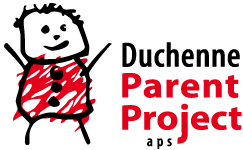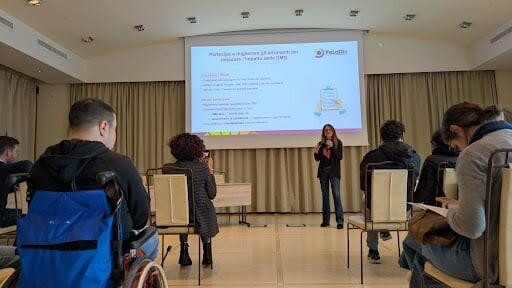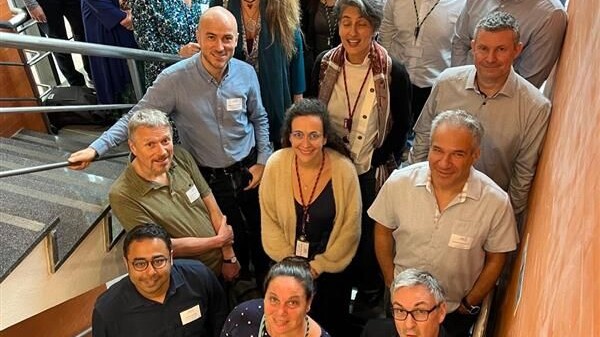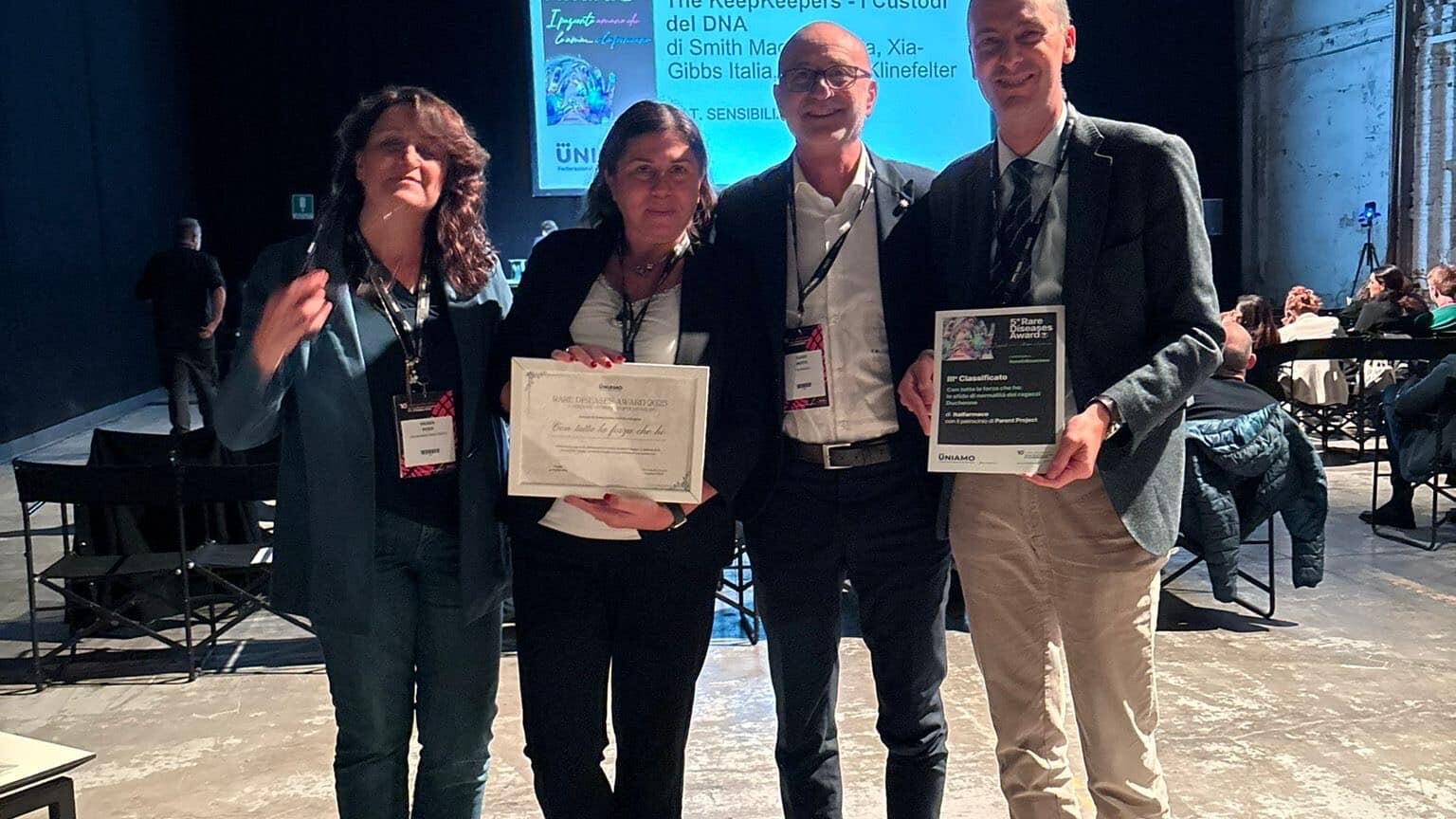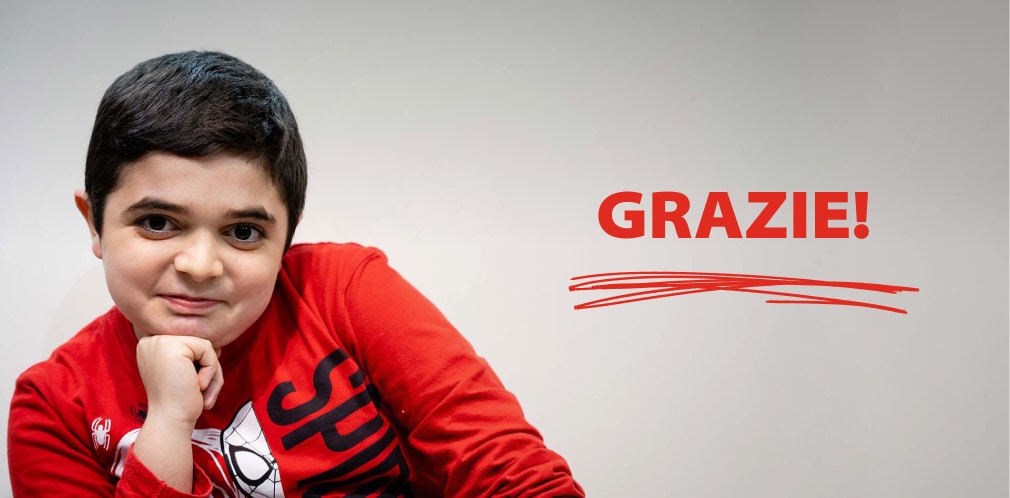Nell’ambito della recente giornata formativa organizzata da TREAT-NMD, svoltasi a Milano lo scorso 14 settembre, sono state presentate le traduzioni in diverse lingue delle Linee guida per la gestione clinica della distrofia muscolare di Becker (BMD).
Le Linee Guida sono il primo strumento al mondo di questo tipo per pazienti e famiglie specifico su questa patologia. La pubblicazione, frutto di un forte bisogno espresso dalla stessa comunità di pazienti, è stata realizzata da Parent Project nel 2021 grazie al contributo di molti specialisti impegnati da anni nella presa in carico dei pazienti, con il coordinamento della Prof.ssa Elena Pegoraro del Dipartimento di Neuroscienze dell’Università di Padova.
Il documento – dal titolo Diagnosi e gestione della distrofia muscolare di Becker . Una guida per le famiglie – è disponibile in formato digitale, scaricabile dal sito dell’associazione e tocca tutti i più importanti aspetti della gestione clinica della patologia, con un’attenzione anche alla sfera psicologica e sociale. Parent Project ha curato, recentemente, anche la traduzione in inglese di questo materiale, rendendolo così disponibile ad un pubblico internazionale estremamente ampio.
L’iniziativa si è realizzata in collaborazione con TREAT-NMD –una rete globale dedicata a informare, mettere in contatto e far progredire la ricerca, i trattamenti e la presa in carico nel campo delle malattie neuromuscolari – che ha curato la traduzione del documento in altre lingue (spagnolo, olandese, tedesco e francese).
Perché le Linee guida sulla BMD
Dato che la patologia ha molti elementi in comune con la distrofia muscolare di Duchenne (il cui decorso è più severo), a lungo è stato adottato lo stesso approccio clinico per entrambe. Negli ultimi 3 decenni la conoscenza e la visibilità della DMD sono aumentate, così come si sono moltiplicati gli studi e le ricerche per individuare delle strategie terapeutiche volte ad affrontarla. Col passare del tempo, è emersa la necessità di dedicare anche alla BMD un’attenzione specifica, sia per le sue diverse caratteristiche, sia perché oggi è possibile adottare approcci più mirati per la BMD nell’ambito delle nuove terapie in sviluppo.
Come riportato nell’introduzione, a cura di Antonio Bellon, socio di Parent Project, attualmente non esiste una vera e propria cura per la distrofia di Becker. Esistono, invece, numerose terapie in grado di migliorare le condizioni cliniche dei pazienti e la loro qualità di vita, e la ricerca sta compiendo sostanziali passi in avanti. Ricevere una diagnosi tempestiva e cercare di preservare la forza e la funzione muscolare è fondamentale per poter utilizzare nel modo migliore le nuove terapie.
Questa guida, frutto di un lavoro collaborativo tra associazione e specialisti nelle malattie neuromuscolari, si propone di fornire ai pazienti BMD ed alle loro famiglie uno strumento agile ma non per questo meno accurato, per ricevere informazioni sui vari aspetti della patologia
Ezio Magnano, Presidente di Parent Project aps, dichiara: «Tre anni fa abbiamo realizzato, per i pazienti Becker, un importante strumento di riferimento, il primo a livello mondiale. Oggi è una grande soddisfazione poterne diffondere la versione in inglese, per metterla a disposizione di tantissimi pazienti e famiglie in tutto il mondo. Un grande ringraziamento va, ancora una volta, a tutte le persone che hanno contribuito a raggiungere questo prezioso obiettivo. »
La traduzione delle Linee Guida è stata realizzata grazie al supporto non condizionato di Edgewise Therapeutics e Santhera Pharmaceuticals.
BMD guidelines are now available in English
As part of the recent Becker Education and Engagement Day organised by TREAT-NMD, which took place in Milan on September 14, the translations into various languages of the Guidelines for the clinical management of Becker muscular dystrophy (BMD) were presented.
The Guidelines are the first tool of this type in the world for patients and families specific to this disease. The publication, the result of a strong need expressed by the patient community itself, was created by Parent Project in 2021 thanks to the contribution of many specialists who have been involved in patient care for years, with the coordination of Prof. Elena Pegoraro of the Department of Neuroscience from the University of Padua.
The document – titled Diagnosis and management of Becker muscular dystrophy. A guide for families – is available in digital format, downloadable from the association’s website and touches on all the most important aspects of the clinical management of the pathology, with attention also to the psychological and social sphere. Parent Project has recently also translated this material into English, thus making it available to an extremely wide international audience.
The initiative was carried out in collaboration with TREAT-NMD – a global network dedicated to informing, connecting, and advancing research, treatment, and care in the field of neuromuscular diseases – which coordinated the translation of the document into other languages (Spanish, Dutch, German and French).
Why the BMD Guidelines
Since BMD has many elements in common with Duchenne muscular dystrophy (whose course is more severe), the same clinical approach was adopted for both for a long time. Over the last 3 decades, knowledge and visibility of DMD have increased, while studies and research have multiplied to identify therapeutic strategies. As time passed, the need to dedicate specific attention to BMD also emerged, both due to its different characteristics and because today it is possible to adopt more targeted approaches for BMD in the context of new therapies in development.
As reported in the introduction, by Antonio Bellon, member of Parent Project, there is currently no cure for Becker muscular dystrophy. However, there are numerous therapies capable of improving patients’ clinical conditions and their quality of life, and research is making substantial progress. Receiving a timely diagnosis and trying to preserve muscle strength and function is essential to be able to make the best use of new therapies.
This guide, the result of collaborative work between the association and specialists in neuromuscular diseases, aims to provide BMD patients and their families with an agile but no less accurate tool to receive information on the various aspects of the pathology.
Ezio Magnano, President of Parent Project aps, declared: «Three years ago we created an important reference tool for Becker patients, the first in the world. Today it is a great satisfaction to be able to share the English version, to make it available to many patients and families all over the world. A big thank you goes, once again, to all the people who contributed to achieving this precious goal.»
The English translation of the Guidelines received the unconditional support of Edgewise Therapeutics and Santhera Pharmaceuticals.
Dona ora!
Per un futuro di qualità e un mondo con una cura per la distrofia muscolare di Duchenne e Becker.
Notizie correlate
25 Nov 2025
PaLaDin: al via le prime compilazioni dei questionari sulla qualità della vita nella DMD
Durante il recente meeting territoriale per famiglie e pazienti organizzato da Parent Project a Genova il 26 ottobre, abbiamo realizzato alcune…
24 Nov 2025
MAGIC: collaborazione e innovazione per le terapie avanzate nelle malattie neuromuscolari
Recentemente la nostra biologa dell’Ufficio Scientifico Ilaria Zito ha partecipato a Lisbona alla General Assembly del progetto europeo MAGIC,…
5 Nov 2025
La campagna Con tutta la forza che ho premiata al Rare Diseases Award di UNIAMO
Con tutta la forza che ho, la campagna di sensibilizzazione promossa da Italfarmaco, con il patrocinio di Parent Project aps, ha vinto il terzo…
